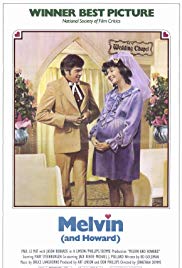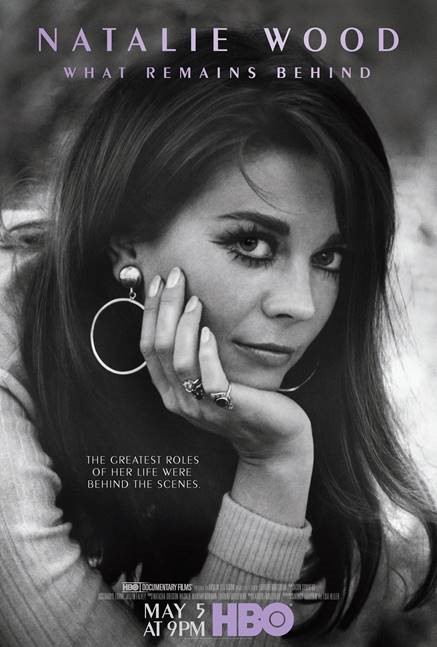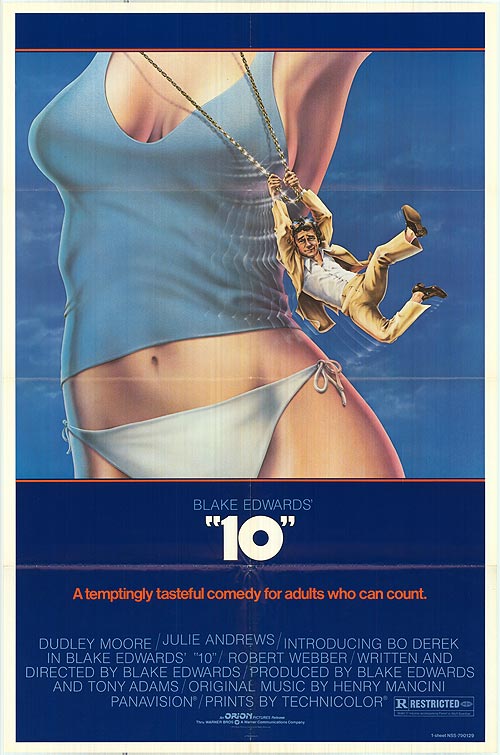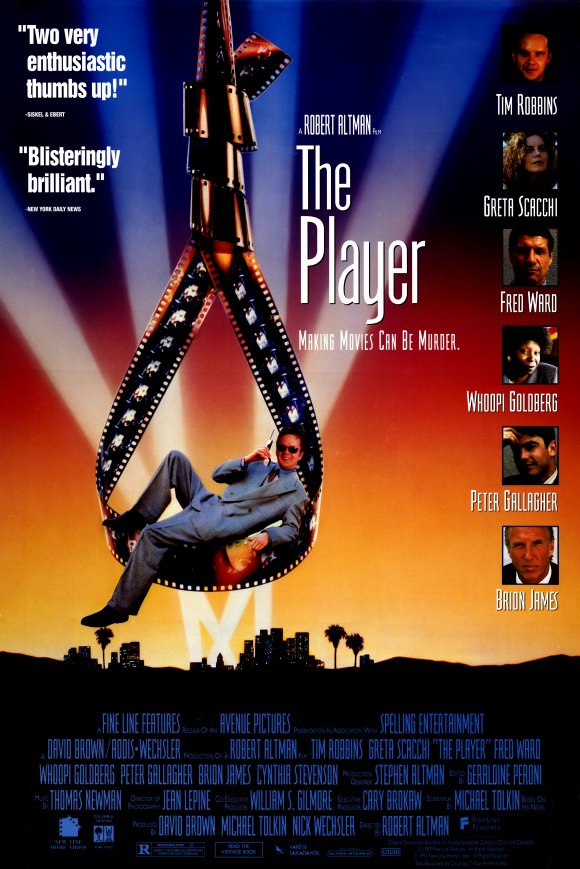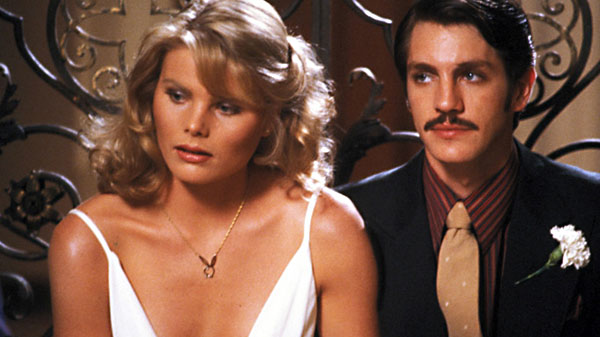
‘Star 80’ — a director obsessed with Hollywood; a character obsessed with Telly Savalas
At the end of his 4-star review of “Star 80,” Roger Ebert poses a great question: “What is the point?”
Well, director Bob Fosse, in a fascinating 1983 interview about the film with Chicago Tribune critic Gene Siskel, evidently struggled with that too. Fosse says that the death of Dorothy Stratten can’t be blamed totally on the perpetrator, nor on adult magazines, nor on Hollywood. He finally arrives at, “It’s screwed up values! ... No one wants to be ordinary. Everyone wants to be special.” (Translation: Everyone needs a reminder that this awful event happened in a place I can’t stand.)
An interesting debate takes place early in “Star 80.” A sleazy promoter is trying to convince a couple of car-show hostesses to have dinner with some auto executives. The hostesses suspect they are actually being set up for a prostitution gig. One of them won’t do it. But the other one will.
That promoter, Paul Snider, is well aware that there is not only a market for less-than-savory services but individuals willing to supply it. Most people, even savvy operators, aren’t comfortable dealing in this realm of the economy. Snider is, because he happens to be antisocial. As he states early in the film, for no apparent reason, “(Expletive) you all, bastards,”
That’s the real movie here. The progression of a sociopath whose last act is a grotesque leap from anything he’s done previously. Which is probably the typical M.O. of most spousal slayings. Snider was investigated, and “there was no record of him being violent,” Hugh Hefner told Siskel in 1983. Had Fosse lived long enough (he died in 1987), he could’ve tried to figure out Scott Peterson. Why would Laci have any reason to think her life was in danger? This horrific type of crime is probably among the most unexpected. That’s scary. That’s why critics called “Star 80” a horror film.
Fortunately/unfortunately, this is something actors relish. Eric Roberts’ work as Snider is no less impressive than what Heath Ledger or Joaquin Phoenix did with The Joker. Yet Roberts only garnered a Golden Globe nomination (he didn’t win; he lost to a tie between Robert Duvall (“Tender Mercies”) and Tom Courtenay (“The Dresser”)), nothing from the Academy Awards. Maybe the story was just too real to appreciate.
“I think the movie is more about rejection ... about what rejection can do to a seemingly innocuous, sleazy but not dangerous character,” Fosse told Siskel in 1983. That’s a chilling implication. People get rejected all the time. Collectively, it’s a way of life. Not everyone can get into Yale. Not everyone can get hired at Google. Not everyone can date Playmates of the Month. If everyone who ever gets rejected by someone has to be presumed capable of murder, then we’re all in big trouble.
The problem with Fosse’s theory is that it’s not matched by his facts on the ground. In “Star 80,” Snider has other pursuits besides Dorothy, and his most likely response to her divorce move seemingly would be some form of blackmail, perhaps threatening to sell old photos to another magazine or take out an injunction against Playboy. He used Dorothy; he was never obsessed with her. This is a serious hustler. People like that are impossible to offend. There’s something else going on that this film, nor any psychiatrist, is ever going to grasp.
Fosse makes a very important decision about his film’s structure. Rather than save the ending for the ending, he introduces the final scene at the beginning and then presents the rest of the film as a flashback. The risk is that some may conclude that if Aug. 14, 1980, never happened, then there’s no movie. Which is a disservice to the rest of the material. Is it a movie? Maybe not. But it’s something.
Marking an intriguing point in cultural history, “Star 80” gains momentum with time. It looks much like a ’70s work and refreshingly lacks the cleaner appearances that most films had by 1983. In Panaflex 35mm, “Star 80” kind of feels like “Melvin and Howard,” a 1980 film also about a real pop-culture occurrence. People old enough to remember the late 1970s will recall the mud-wrestling promotions, the wet T-shirt contests, disco, the home fitness craze. Playboy was past its peak but still a formidable force of polarization.
“Star 80” uses a couple of questionable devices — in many films, they would be called “crutches” — to speed the story. But those devices allow Fosse to pack the film into about a hundred concise minutes, a major plus. Acquaintances of Paul Snider — including Dorothy — deliver narrations that shorten the time Fosse would otherwise need to show what kind of person Snider is. From those narrations, Fosse’s scenes are hit and miss. Two women climbing into a car with Snider to privately discuss an assignment is a great scene. But instances of Snider complaining about the gross revenue from his nightclub events or the explanation of how he ripped off a photographer (who surely should’ve known better) feel more like necessary mileposts rather than acting. Even so, Snider’s variety of ventures brings a certain amount of anticipation; you can’t help but wonder what he’s got next. “Star 80” feels like Stratten’s career, a missile from nowhere into pop-culture stratosphere without any GPS, capable of exploding anywhere.
Playboy was one of the world’s most controversial companies. (It’s not anymore.) Its worst day was likely the death of Dorothy Stratten. Stratten, like Amelia Earhart and Sharon Tate and Karen Silkwood, is famous today for how she died. Like Tate, she was the victim of a horrifying, senseless crime. Notably, no major motion picture has ever depicted the Tate-LaBianca murders as matter-of-factly as the treatment of Stratten in “Star 80.” That isn’t to say “Star 80” is insensitive. It’s not. It’s just ... frank. Fosse realizes that for whatever reason, while we can’t visualize Tex Watson holding a knife, showing Paul Snider talking to himself in the nude, blood sprayed over his face, is within the boundaries of art.
Mariel Hemingway doesn’t quite resemble Dorothy Stratten, and (despite top billing) she doesn’t own her scenes as Roberts does. But she’s perfect. The role requires a willingness to pose nude. Whether it’s art or exploitation doesn’t matter; what matters is that Dorothy convinces herself it’s art. In this movie of sharks and piranhas, there is only one innocent character — Dorothy, a deer in the headlights. (It is a bit hard to believe, as the movie suggests, that this future Playmate of the Year passed through high school rather anonymously.) She is someone in need of a protector, but there isn’t one. Her mother tried ... but how hard? Hugh Hefner told Gene Siskel, in his own conversation published the same day as the Fosse interview in 1983, that “she did object to it. But by the end, she was hoping that Dorothy would become Playmate of the Year.”
A movie about a famous pin-up, such as Dorothy Stratten or Natalie Wood, knows it can’t really do any better than vintage photos of the star. Fosse correctly realizes though that the drama is with Snider, not Dorothy. He plasters photos of Dorothy across an opening montage, then takes his foot off the gas pedal. (It would’ve taken courage to not show any pictorial images of Dorothy, but Fosse doesn’t go that far.) Hemingway’s photo shoots are probably more than a macguffin, they’re the protagonist’s meal ticket, but it’s not the photos that drive the film — it’s the maneuvering about them.
In case anyone hadn’t already figured it out, “Star 80” indicates that the background isn’t nearly as pretty as the models. Single-parent homes, family arguments, working-class environments, shady business associates, diamonds in the rough. Even in Dorothy’s working-class home, where big breaks might be rare, joining Playboy can’t happen without a fierce standoff. There must be some Playmates whose parents went to the Ivy League. Playboy seems like an all-star team of girls whose parents aren’t exactly IBM executives.
“Star 80,” in razor-sharp intimacy, tells us much about the world of Playboy. It doesn’t have to go find the talent; the talent finds it. So much so that the kingpins spend their business hours merely picking their favorite photos. But all of this beauty comes with baggage which, according to “Star 80,” Playboy simply chalks up to business expenses. (It’s not even mentioned in the film, but Stratten’s actual family name was Hoogstraten, but we all know Hoog doesn’t sound very sexy, so that’s why we know her as Stratten.)
Some will say that Dorothy is exploited; others not. Fosse suggests an impossible balance in the world of Playboy between age and demand — when the girls are most appealing to Hugh Hefner, they are quite possibly too young to work for him. (Here’s another important cultural distinction — in America, Dorothy at 18 would be free to go to L.A.; in her home of British Columbia, the age is 19, prompting a standoff between mom and Snider.) In exchange for Dorothy agreeing to take her clothes off, Playboy agrees to hire her and gives her money, status, entree to Hollywood elites that many covet. Playboy’s business decisions appear highly disciplined, with several handlers always around to ensure no missteps by either Hefner or the Playmates. Hefner even bluntly tells Dorothy that Snider is no good. But even Hef is unable to stop her from marrying him. Why does she do it? Fosse can’t explain it.
Titles of movies are intriguing. The term “Star 80” is never spoken. Fosse reveals its significance (in some references, STAR is all-caps) in a very subtle scene depicting a luxury car. Admittedly, Blake Edwards in “10” already beat him to the punch, four years earlier. In his 1983 Tribune interview, Fosse said, “Vanity license plates are typical of California. It started there and has spread to the rest of the country.”
There are many films about the seemier side of Hollywood. (Start with “The Player” and work backwards.) “Star 80” checks about all the boxes, though drugs curiously seem to be absent. An underage woman, exploited. A director sleeping with one of his actresses. Dubious hangers-on crashing VIP parties and pretending to know important people. Distracted actors who can’t show up on time. Spendthrifts blowing the money earned by hard-working partners or associates. The movement of beautiful human beings like cattle, through the mansion parties through the movie sets through the nightclubs through the casting couches, all vulnerable to be replaced by someone who’s just a little younger.
There is more drama to “Star 80” that occurred after Aug. 14, 1980. That movie that Dorothy was shooting is called “They All Laughed.” Its director is the famed Peter Bogdanovich, who indeed was having an affair with Stratten. (Why Hefner was portrayed by name in “Star 80” and Bogdanovich was not presumably has to do with lawsuit threats.) When Sharon Tate died, her films were immediately re-released. “They All Laughed” was the property of Time-Life Films, a division about to be shut down by Time Inc. Whether scared by the murder of Stratten or simply unimpressed by Bogdanovich’s work, Time-Life apparently intended to shelve the project, prompting Bogdanovich to buy the rights for about $5 million. He tried to self-distribute, took a bath and ended up in a bankruptcy filing in 1985.
Bogdanovich in 1983 told Siskel that he considered the “Star 80” script, which he had seen, to be “most exploitive.” He also states that STAR 80 “was the license plate Snider got for Dorothy’s car, which was a ’67 Cougar. He drove a ’79 Mercedes with the license plate GALAXINA, the title of her first picture.”
Had Bogdanovich been writing/directing “Star 80,” it likely would’ve told a different story. “She has been portrayed as some kind of ingenue who was eaten alive by Hollywood,” Bogdanovich said. “Well, she may have looked like an ingenue, but in reality she was a very grown-up woman.” Snider, Bogdanovich adds, “was just obviously crazy.”
Bogdanovich and Fosse may be on opposite sides in L.A., but each was a lot more fascinated by the Dorothy Stratten story than the general public was. According to Box Office Mojo, “Star 80” grossed $6 million. It cost $12 million. Fosse made a point. But Hollywood got him again.
3.5 stars
(September 2021)
“Star 80” (1983)
Starring
Mariel Hemingway
as Dorothy ♦
Eric Roberts
as Paul ♦
Cliff Robertson
as Hugh Hefner ♦
Carroll Baker
as Dorothy’s Mother ♦
Roger Rees
as Aram Nicholas ♦
David Clennon
as Geb ♦
Josh Mostel
as Private Detective ♦
Lisa Gordon
as Eileen ♦
Sidney Miller
as Nightclub Owner ♦
Keith Hefner
as Photographer ♦
Tina Willson
as Bobo Weller ♦
Shelly Ingram
as Betty ♦
Sheila Anderson
as Exotic Dancer ♦
Cis Rundle
as Meg Davis ♦
Kathryn Witt
as Robin ♦
Jordan Christopher
as Peter Rose ♦
James Luisi
as Roy ♦
Neva Patterson
as Playboy Executive ♦
Robert Fields
as Director ♦
Keenen Ivory Wayans
as Comic ♦
Sandy Wolshin
as Woman M.C. ♦
Robert Perault
as Actor ♦
James Blendick
as Gunseller ♦
Jacqueline Coleman
as Nightclub Dancer ♦
Don Granbery
as Bartender ♦
Stuart Damon
as Vince Roberts ♦
Ernest Thompson
as Phil Wass ♦
Budd Friedman
as Emcee ♦
Deborah Geffner
as Billie ♦
Norman Browning
as 1st Detective ♦
Hagan Beggs
as 2nd Detective ♦
Bobby Bass
as 1st Hood ♦
Gilbert B. Combs
as 2nd Hood ♦
Tabitha Herrington
as Blonde ♦
Dean Hajum
as George ♦
Dan Zaleski
as The Jock ♦
Paul Ryan
as Radio Interviewer ♦
Michael Joel Shapiro
as Playboy Assistant ♦
Fred Pierce
as Head Butler ♦
John Horn
as Nightclub Owner L.A. ♦
David W. Rose
as Assistant Director ♦
Stanley Kamel
as Nick ♦
Liz Sheridan
as Makeup Woman ♦
Liis Kailey
as Aram’s Assistant ♦
Robert Picardo
as Interviewer ♦
Erica Yohn
as Interviewer ♦
Marilyn Madderom
as Editor ♦
Lonny Chin
as Playboy Mansion Guest ♦
Venus Pinkston
as Playboy Mansion Guest ♦
Tracy Vaccaro
as Playboy Mansion Guest ♦
Michele Hill
as Playboy Mansion Guest ♦
Kim St. Leon
as Playboy Mansion Guest ♦
Sulinda Watson
as Playboy Mansion Guest ♦
Cathy St. George
as Playboy Mansion Guest ♦
Katrina von Splawn
as Playboy Mansion Guest ♦
Carol Hills
as Playboy Mansion Guest ♦
Kristine Garbo
as Playboy Mansion Guest ♦
Catherine Gilmore
as Playboy Mansion Guest ♦
Charlene Howell
as Playboy Mansion Guest ♦
David O. Cameron
as Paul’s Party Guest ♦
Stacey M. Toten
as Paul’s Party Guest ♦
Michael Levittan
as Paul’s Party Guest ♦
Lorraine Michaels
as Paul’s Party Guest ♦
Bonnie Kanner
as Paul’s Party Guest ♦
Toni Petrie
as Paul’s Party Guest ♦
Don Jones
as Getaway - Prom Band ♦
George McKensie
as Getaway - Prom Band ♦
Martin Eade
as Getaway - Prom Band ♦
Jim Cross
as Getaway - Prom Band ♦
Don Kitchen
as Getaway - Prom Band ♦
Rick Webb
as Getaway - Prom Band ♦
Peter Ohrnberger
as Getaway - Prom Band
Directed by: Bob Fosse
Written by: Bob Fosse, based on an article written by Teresa Carpenter in Village Voice
Producer: Wolfgang Glattes
Producer: Kenneth Utt
Associate producer: Grace Blake
Music: Ralph Burns
Cinematography: Sven Nykvist
Editing: Alan Helm
Casting: Howard Feuer, Jeremy Ritzer
Art direction: Michael Bolton, Jack G. Taylor Jr.
Set decoration: Ann McCulley, Kimberley Richardson
Costumes: Albert Wolsky
Makeup and hair: Ken Chase, Susan Germaine
Production manager: Kenneth Utt
Unit production manager: Larry Rapaport
Unit production manager: Paul L. Tucker
Stunts: Gilbert B. Combs

